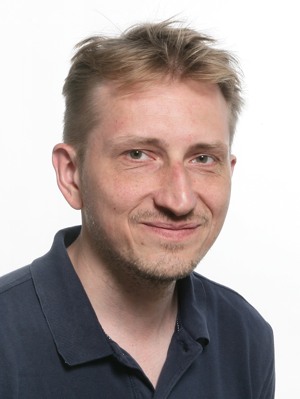Dmitry Kovrizhin

Dr Dmitry Kovrizhin
EPSRC Advanced Research Fellow
Office: 518 Mott Bld
Phone: +44(0)1223 3 39582
Email: dk487 @ cam.ac.uk
Personal web site
TCM Group, Cavendish Laboratory
19 JJ Thomson Avenue,
Cambridge, CB3 0HE UK.
Research Group

Research
I am a condensed matter theorist. My research is about physical phenomena which arise as a result of a collective behaviour of many interacting quantum particles. One of the main areas of my work is the field of non-equilibrium quantum systems, where I studied e.g. electronic interferometers, and thermalisation of electrons in quantum Hall edge states. I have also developed theoretical methods of "non-equilibrium bosonization". More recently I have been working on non-equilibrium dynamics of quantum spin-liquids, where I calculated the spin dynamic structure factor of the Kitaev model. Below is the list of my current research interests.
- non-equilibrium quantum systems
- frustrated magnetism, quantum spin liquids
- topological phases
- topological defects and textures

In Plain English
Non-equilibrium quantum systems: The occurrence of non-equilibrium behaviour is very common in nature. One of the simplest examples of that is when two objects with different temperatures come into contact. Other non-equilibrium settings can show various levels of complexity from the physical process that leads to emission of a laser to the ultimate case of living organisms. The common characteristic property of these systems is the absence of uniform thermodynamic quantities such as temperature.
Some of the non-equilibrium experiments are being done with nano-structures in high magnetic fields and at very low temperatures. In these systems electrons move in a coherent way similar to photons in a laser beam. Remarkably, as a result of strong interactions the electrons form emergent correlated states which harbour quasi-particles with a fraction of electron charge. Similar quasi-particles also occur in magnetic materials in the so-called quantum spin liquid states. In the future it is hoped that these particles will be used as building blocks of topological quantum computers. The problem of quantum motion of a large collection of quasi-particles is in the class of non-equilibrium quantum problems, whose study constitutes one of the main areas of my research.
Interestingly, many of these systems show non-equilibrium steady states. Take a piece of metal and connect it on opposite sides to a heater and a refrigerator, — which will result in a steady heat flow. A similar situation occurs in a system of interacting electrons in a quantum wire connected to a battery. The important differences with the former arises from the fact that the motion of particles in the wire obeys the laws of quantum mechanics, which lead to unusual quantum states. Recently it became possible to study these states in experiments, which resulted in a number of unexpected observations. Next generation experiments will build quantum devices, which iwill explore the physics of non-equilibrium states, based on new theoretical and experimental insights.
My research is aimed at theoretical understanding of quantum systems driven far from equilibrium by, for example, applied voltage or fast switching of external fields. In these settings many physical systems with examples ranging from semiconductor nano-structures and superconductors, to quantum magnets and ultra-cold atomic gases show remarkable emergent behaviour. This comes as a result of an intricate quantum entanglement which occurs due to the motion of interacting particles under non-equilibrium conditions. The properties of these systems cannot be explained using standard theoretical framework, and it is the one of the central tasks of my work to develop this theoretical description.
Featured Publications
* complete list of publications is available here, my papers can also be found on arXiv
Dynamics of a Two-Dimensional Quantum Spin Liquid: Signatures of Emergent Majorana Fermions and Fluxes J. Knolle, D. L. Kovrizhin, J. T. Chalker, and R. Moessner Phys. Rev. Lett. 112, 207203, (2014) [PRL, arXiv:1308.4336] see physics viewpoint by Alexei Tsvelik Quasiparticle Signatures in Quantum Spin Liquids
Bulk-edge correspondence in fractional Chern insulators Zhao Liu, D. L. Kovrizhin, and Emil J. Bergholtz Phys. Rev. B 88, 081106(R), (2013) [PRB (Rapid Comm), arXiv:1304.1323]
Multicomponent Skyrmion Lattices and Their Excitations D. L. Kovrizhin, Benoît Douçot, and R. Moessner Phys. Rev. Lett. 110, 186802 (2013) [PRL, arXiv:1207.4021]
Relaxation in Driven Integer Quantum Hall Edge States D. L. Kovrizhin and J. T. Chalker Phys. Rev. Lett. 109, 106403 (2012) [PRL, arXiv:1111.3914]
Exactly solved model for an electronic Mach-Zehnder
interferometer
D. L. Kovrizhin and J. T. Chalker
Phys. Rev. B 80, 161306(R) (2009) [PRB
(Rapid Comm) ![]() , arXiv:0903.3387]
, arXiv:0903.3387]
Density matrix renormalization group for bosonic quantum Hall effect D. L. Kovrizhin Phys. Rev. B 81, 125130 (2010) [PRB, arXiv:0909.3693]
Bose-Einstein Condensation of Magnons in Cs2CuCl4 T. Radu, H. Wilhelm, V. Yushankhai, D. Kovrizhin, R. Coldea, Z. Tylczynski, T. Lühmann, and F. Steglich Phys. Rev. Lett. 95, 127202 (2005) [PRL, cond-mat/0505058] also advertised in "First Bose-Einstein Condensate in a Solid", Physics News Update 746 2 (2005)
Anomalous Tunneling of Phonon Excitations between Two Bose-Einstein Condensates Yu. Kagan, D. L. Kovrizhin, and L. A. Maksimov Phys. Rev. Lett. 90, 130402 (2003) [PRL, cond-mat/0210329]